![]()
Building a Weatherproof Housing
for the FMV1 Microphone (Page 3)
by Matt M.
![]()
The following two pictures show how the mic is strapped to tree. The first one shows how the leather strap is used to strap to the tree trunk just underneath where a limb is branching out from the trunck. This is the best position to strap it because it allows you to point the funnel more veritically downward and while still enabling you to strap the mic tightly so it doesn't blow in the wind. Neither the mic nor the antenna wire should hang loose enough to blow in the wind, or else the signal from the mic won't be steady.
The second picture shows how I hung a few strips of camo tape to immitate peeling bark or dead leaves. The irregular strips help make the mic appear very organic from a distance.
Just above the strips of tape you can see the aligator clip of the antenna wire clamped onto the antenna bolt. In the first picture you can just barely see the antenna wire extending horizontally from the mic to the trunk of the tree. The wire leads to a nail then goes straight down along the trunk as seen in the next set of pictures.
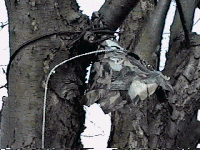
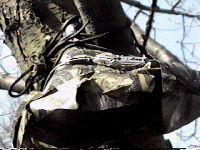
![]()
The next two pictures show how the antenna wire is affixed to the tree trunk. The first picture shows how I looped the antenna wire tightly around a nail to hold it steady. The nail itself was wrapped with a piece of electricians tape to help reduce the grounding effect of the nail-tree-ground path. The second picture shows the aligator clip on the far end of the antenna wire clamped to another nail which has been wrapped with electrician's tape.
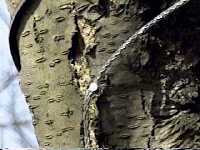
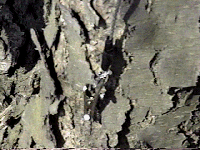
![]()
This last picture shows a frequency counter placed next to the antenna wire when it was still on the worktable. You'll need to buy or borrow one of these devices in order to tune the microphone to the proper frequency. The tuning screw is extremely sensitive and will jump from 80Mhz to 90Mhz with only a slight turn of the screw. You have to use extremely gentle turning movements to get the mic to a particular decimal frequency such as 87.5 Mhz.
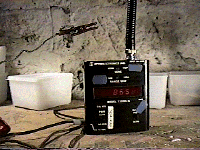
![]()
Previous Page : Building the mic housing, page 2.
![]()
Bigfoot
Field Researchers' Homepage
Submit a report,
an article, or comments.